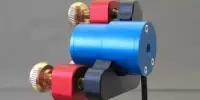Semiconductor ring lasers (SRLs) are small ring laser devices that could be used in optoelectronics, photonics, and all-optical circuits. It is a type of laser that generates coherent light by using semiconductor materials. Its ring-shaped resonator construction, which can exhibit unique features and advantages, distinguishes it from typical semiconductor lasers. The first SRLs appeared in the 1980s. They have recently piqued the curiosity of researchers as prospective random-access memory storage systems for all-optical computers.
Semiconductor ring lasers are optical waveguides with a lasing medium that are physically ring-shaped. They can trap light in a ring and recirculate it indefinitely as long as they are energized. Indium phosphide is the preferred material for SRLs.
Here are some key points about semiconductor ring lasers:
- Resonator Structure: In contrast to typical semiconductor lasers, SRLs have a ring-shaped or circular resonator construction. A loop or ring-shaped waveguide is formed in the semiconductor material to form the ring resonator.
- Gain Medium: SRLs, like other semiconductor lasers, employ a semiconductor gain medium, which is frequently based on materials such as gallium arsenide (GaAs) or indium phosphide (InP). Typically, the gain medium is doped to introduce the population inversion required for laser operation.
- Feedback Mechanism: The laser cavity receives feedback from the ring resonator. Light generated within the gain medium travels in a closed loop, interacting with it and reinforcing specific wavelengths. This feedback mechanism results in laser activity.
- Wavelength Control: The ring structure allows for the control of the emission wavelength. By adjusting the ring’s geometry and the current applied to the gain medium, specific wavelengths can be selected. This makes SRLs tunable and suitable for various applications, including optical communications and sensing.
- Compact Size: SRLs are often compact and can be integrated into semiconductor devices or optical circuits. This compactness makes them suitable for on-chip optical applications, such as optical interconnects in data centers and communication systems.
Applications
Semiconductor ring lasers are used in a variety of sectors, including telecommunications, optical sensing, and optical clock dissemination. They are utilized in wavelength-division multiplexing (WDM) systems, optical frequency combs, and other applications.
SRLs can be square with corner reflectors or, as is more frequent with smaller versions, curved with a “racetrack” shape. Devices are currently on the order of 100 micrometres, but further downsizing should be attainable utilizing existing silicon microelectronics technology.
Overall, semiconductor ring lasers are adaptable devices with unique properties that make them desirable for a wide range of photonic applications, notably in the context of integrated optics and high-speed data transmission.















